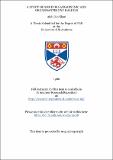Files in this item
A study of some organoarsenic and organoantimony halides
Item metadata
| dc.contributor.advisor | Harris, G. S. | |
| dc.contributor.author | Khan, Abdullah | |
| dc.coverage.spatial | iv, 198 p. | en_US |
| dc.date.accessioned | 2018-07-04T13:06:58Z | |
| dc.date.available | 2018-07-04T13:06:58Z | |
| dc.date.issued | 1986 | |
| dc.identifier.uri | https://hdl.handle.net/10023/14918 | |
| dc.description.abstract | Triarylarsine halides The reactions of tri(2-, 3-, 4-methylphenyl)-, tri(dimethylphenyl)-, tri(2-, 3-, 4-fluorophenyl)-, tris(2-, 3-, and 4-trifluoromethylphenyl)arsine with halogens (bromine, iodine and iodine bromide) have been studied by conductometric titration in acetonitrile. In general, evidence was obtained for the formation, in solution, of 1:1 and 2:1 adducts (R₃AsX₂ and R₃AsX₄). All of the possible 1:1 and 2:1 adducts were isolated as crystalline solids and the electrolytic conductivity of their acetonitrile or nitrobenzene solutions was measured. The molar conductivity value for each compound (at Cm = 0.01 mol dm⁻³) was calculated. All of the compounds of type R₃AsCl₂ are weak electrolytes except (2-CH₃C₆H₄) ₃AsCl₂ which is a medium electrolyte; and all of the R₃AsBr₂ compounds are weak or medium electrolytes except (2-CH₃C₆H₄) ₃AsBr₂ which has a molar conductivity value approaching that of a strong electrolyte. The molar conductivity values of the dibromide adducts are always higher than those of the corresponding dichloride adducts. Comparison of the relative values of the molar conductivity of the adducts (YC₆H₄) ₃AsX₂ [Y = H, CH₃, F, CF₃ and X = Cl, Br] with the relative values of acid strengths of the corresponding substituted benzoic acids, YC₆H₄COOH, is made. The higher molar conductivity of R₃AsI₂ and R₃AsIBr results from their disproportionation R₃AsX₂ □(→┬ ) ½ R ₃ As + ½AsX⁺X₃ All of the 2:1 adducts, R₃AsX₄ are strong electrolytes in acetonitrile solution and are formulated R₃AsX⁺ X₃⁻. The mixed tetrahalides R₃AsCl₃I and R₃AsBr₃I, were indicated from the reactions of R₃AsCl₂ with ICl and R₃AsBr₂ with IBr, and they can be obtained as solid adducts. These compounds ionise completely in acetonitrile and the halogen of lower atomic number resides, without exception, in the cation R₃AsCl₃I R₃AsCl⁺ICl₂⁻ R₃AsBr₃I R₃AsBr⁺ IBr₂⁻ Triarylstibine halides The course of the reactions of tri(2-, 3-, 4-methylphenyl)-, tri(dimethylphenyl)-, tris(2-, and 4-trifluoromethylphenyl)stibine with bromine, iodine and iodine bromide in acetonitrile solution were investigated by conductometric titration in order to observe compounds formation in these systems. All of the 1:1 and 2:1 adducts (R₃SbX₂ and R₃SbX₄) whose existence was shown by the titrations were isolated. The electrolytic conductivity of acetonitrile solutions of the adducts were measured and values of molar conductivity were obtained; all of the compounds of general formula R₃SbX₂ (X = Cl or Br) are either non-electrolytes or very weak electrolytes in acetonitrile. The conductivity of the adducts R₃SbI₂ and R₃SbIBr are high and arise from their disproportionation in acetonitrile: R₃SbI₂ ⇄ ½R₃Sb + ½R₃SbI⁺I₃⁻ R₃SbIBr⇄ ⅓R₃Sb + ⅓R₃SbBr₂ + ⅓R₃SbBr⁺I₃⁻ All of the tetrahalides except (4-CF₃C₆H₄)₃SbI₄ are strong electrolytes. The conductometric titrations of R₃SbCl₂ with ICl and SbCl₅ and R₃SbBr₂ with IBr [R = (CH₃) ₂C₆H₃, 2-CF₃C₆H₄] have been studied in acetonitrile; there is no reaction between R₃SbCl₂ and ICl but with SbCl₅ a highly conducting 2:1 adduct (R₃SbCl+ Sb₂Cl₁₁⁻) is formed. With the exception of [(CH₃)₂C₆H₃]₃SbBr₂, the reaction of R₃SbBr₂ with IBr does not go to completion, but produces an equilibrium mixture of reactants and product: R₃AsBr₂ + IBr R₃SbBr⁺ IBr₂⁻ No solid adduct was obtained. However the adduct [(CH₃)₂C₆H₃]₃SbBr₃I, suggested from the titration graph, was isolated as a solid. It is a strong electrolyte in acetonitrile solution. Tetraphenylstibonium halides. All of the compounds Ph₄SbX (X = F, Cl, Br, I) and Ph₄SbX₃ (X₃ = Br₃, IBr₂, Icl₂) were isolated as crystalline solids. Their electrolytic conductivity was measured in acetonitrile and the molar conductivity was calculated for each compound; Ph₄SbF is a very weak electrolyte. Ph₄SbCl and Ph₄SbBr are weak electrolytes but Ph₄Sbl is a strong electrolyte as are all of the trihalides, Ph₄SbX₃. The conductometric titrations of Ph₄SbCl with ICl and Ph₄SbBr with Br₂ and IBr indicate that the trihalides Ph₄SbX₃ are formed readily in acetonitrile solution. | en_US |
| dc.language.iso | en | en_US |
| dc.publisher | University of St Andrews | |
| dc.subject.lcc | QD305.H15K2 | |
| dc.subject.lcsh | Halides | en |
| dc.title | A study of some organoarsenic and organoantimony halides | en_US |
| dc.type | Thesis | en_US |
| dc.contributor.sponsor | Pakistan. Ministry of education | en_US |
| dc.type.qualificationlevel | Doctoral | en_US |
| dc.type.qualificationname | PhD Doctor of Philosophy | en_US |
| dc.publisher.institution | The University of St Andrews | en_US |
This item appears in the following Collection(s)
Items in the St Andrews Research Repository are protected by copyright, with all rights reserved, unless otherwise indicated.

